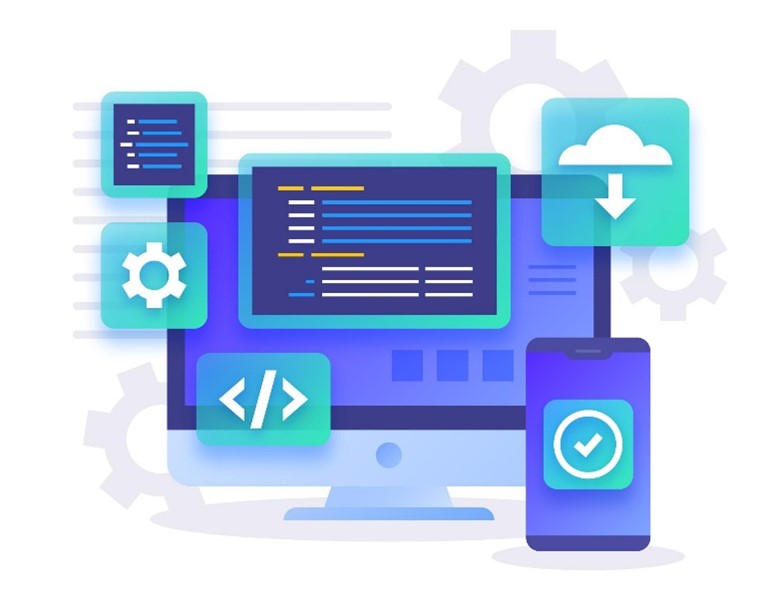With the growth of digital technology and the advent of artificial intelligence, many experts predict that we’ll see a massive increase in the use of digital marketing techniques and technologies in the year 2023 and beyond.
Digital marketing has become an essential part of any business’s growth strategy, and staying up-to-date with the latest trends is crucial for success in this rapidly evolving field.
As we look ahead to 2023 and the years to come, the digital marketing landscape is set to change yet again, with new technologies and consumer behaviors shaping the way brands reach and engage with their audiences.
In this article, we’ll explore some of the top trending digital marketing strategies, and how businesses can leverage these trends to stay ahead of the competition and connect with their customers in more meaningful ways.
Let’s dive in.
11 Most Trending Digital Marketing Strategies
1. Personalisation
Personalisation will continue to be a major trend in digital marketing in 2023.
From personalised email campaigns to product recommendations based on browsing history records, brands need to go beyond simply addressing customers by their first name.
With the vast amount of data available today and leveraging AI-driven tools to analyse, brands can create customised experiences for their customers.
AI-driven tools such as chatbots and recommendation engines can be used to analyse customer data to provide personalised responses to inquiries and offer product recommendations that are tailored to individual preferences.
Personalisation is a great way to build customer loyalty and increase engagement. Customers are more likely to engage with a brand that offers personalised experiences, and they’re also more likely to return to a brand that understands their needs and preferences.
Famous brands such as Coca Cola have had their share of successes using personalisation as a marketing tool to boost sales.
2. AI-powered Chatbots
With the increasing demand for instant customer service, AI-powered chatbots will become more advanced and sophisticated in 2023. They will be able to provide more personalised responses to customer inquiries and help improve overall customer experience.
Powered by AI-driven tools such as natural language processing (NLP), chatbots can understand and respond to customer inquiries in a more human-like manner that helps improve overall customer experience.
Chatbots can provide personalised product recommendations and offers based on one’s purchase history and browsing behavior. This helps increase customer engagement and loyalty.
Many companies are already using these chatbots to increase customer satisfaction and sales while lowering service costs.
3. Voice Search
Voice search will continue to grow in popularity in 2023.
With the increasing use of voice-activated devices such as Amazon Echo and Google Home, more people are using voice search to find information online.
Businesses need to optimise their content using long-tail keywords and natural language to increase the chances of being featured in voice search results and reaching a wider audience.
Voice-activated devices can also be used to provide personalised experiences for customers. For instance, a restaurant could offer a voice-activated ordering system through Google Home.
Brands that can optimise the content for voice search and leverage voice-activated devices will be well-positioned to reach a wider audience and connect with customers in new and innovative ways.
Find out more about how brands have tapped into the voice interface to enhance customer experience.
4. Social Media Shopping

Social media shopping is becoming more prevalent due to the convenience and hassle-free platforms.
Platforms such as Instagram, Facebook, and Pinterest are some of the popular ones with features that allow users to buy products directly from the apps.
Users’ social experience is further enhanced with social media shopping where brands can advertise and sell on these platforms easily.
The prevalence of virtual reality (VR) technology and its use in social media shopping would allow customers to virtually “try on” products before making a purchase, such as clothes or makeup. VR could also be used to create immersive shopping experiences, such as virtual storefronts or pop-up shops.
5. Influencer Marketing
Influencer marketing will continue to be a key trend in 2023, with brands partnering with influencers to reach new audiences and build trust with their customers.
A good example of influencer marketing is when popular singer Charlie Puth partnered with the Singapore Tourism Board recently in a new campaign to promote Singapore as a tourist destination.
Watch the promotional video Sounds of Singapore with Charlie Puth.
There is an increasing shift towards working with micro-influencers and niche influencers rather than big-name celebrities.
One obvious reason is the lower costs involved.
Another reason is that micro-influencers have higher levels of engagement than larger influencers. These influencers are also more authentic and have lower follower counts of between 1,000 and 10,000 followers. Companies can also reach niche audiences by partnering with micro-influencers.
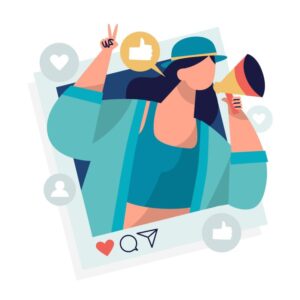
Niche influencers specialise in a specific topic or industry. They can also be valuable partners for brands looking to connect with a specific audience. For example, a brand that sells sustainable clothing may partner with a sustainable fashion blogger or influencer to reach eco-conscious consumers.
By working with these smaller-scale influencers, brands can also save money on marketing expenses and reach a more targeted audience.
Additionally, the use of AI-powered influencer identification and vetting platforms is expected to rise, allowing brands to identify and partner with micro-influencers and niche influencers more easily and effectively.
Overall, influencer marketing is set to remain an important strategy for brands in 2023, with a greater focus on niche and micro-influencers as a way to connect with targeted audiences and build trust with customers.
6. Video Marketing
Video marketing has proven to be a powerful tool for engaging audiences, and this trend is expected to continue into 2023 and beyond.
Videos are a great way to grab the attention of your viewers and showcase your products and services more effectively than still images.
With the rise of short-form video platforms like TikTok, marketers need to shift their focus toward creating concise, attention-grabbing videos that are optimised for various platforms and devices.
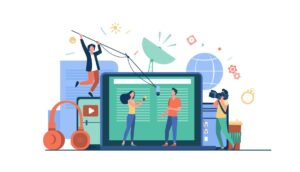
For video marketing to be successful, creating high-quality videos that resonate with viewers is essential. To achieve this, marketers should aim to produce content that is both visually stunning and emotionally engaging, telling a story that connects with their target audience.
In addition to creating compelling content, optimising videos for different platforms like Facebook, Instagram, or Twitter is crucial. Each social media platform has its own video format and aspect ratio. Tailor your videos to fit these requirements to ensure maximum engagement.
For example, videos for Instagram should be in a square format, while those for TikTok should be vertical.
With more people accessing content on mobile devices, it’s important to ensure that videos are optimised for mobile viewing.
Check that videos are not too long and load quickly, so viewers don’t lose interest or become frustrated.
7. Augmented Reality (AR)

Augmented Reality (AR) will continue to be a popular trend in digital marketing in 2023 and beyond.
AR is a technology that superimposes digital information into the real world, providing an interactive and immersive experience. The technology is used for product demos, virtual try-ons, and other interactive experiences. It’s thus no surprise that brands are leveraging AR to create unique and engaging experiences for their customers.
One way that brands are using AR in digital marketing is by offering product demos. AR allows customers to visualise and interact with products in a virtual environment, which can be particularly useful for complex products or ones that are difficult to demonstrate in person.
For example, furniture brands can make use of Amazon AR Room Decorator to allow customers to place virtual furniture in their homes and see how it would look before making a purchase.
Another way that brands are using AR is by offering virtual try-ons. This is particularly relevant for industries such as fashion and beauty, where customers want to try products before making a purchase. AR technology allows customers to virtually try on clothing or makeup, helping them to make a more informed purchase decision.
Examples of retail brands that have tapped into this are Gucci, ASOS and Dulux.
AR can also be used for other interactive experiences, such as gamification. Brands can create games or other interactive experiences using AR, which can be a fun and engaging way to promote their products or services.
Overall, the use of AR in digital marketing provides a unique and immersive experience for customers, allowing brands to differentiate themselves and create memorable interactions with their target audience.
8. Data Privacy
Data privacy has become an increasingly important issue in recent years, as more and more companies collect and use personal data for various purposes.
With the increasing concerns surrounding data privacy, marketers will need to focus on building trust with their customers by protecting their data and complying with regulations such as the Singapore Personal Data Protection Act (PDPA) or the European Union’s General Data Protection Regulation (GDPR). This includes being transparent about data usage and providing options for customers to control their data.
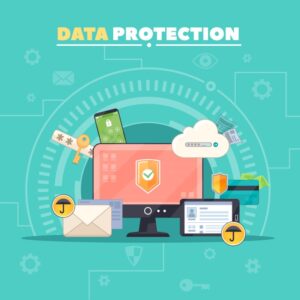
Communicating to customers what data is being collected, why it’s collected, and how it will be used as part of being transparent. Sharing with customers what measures are taken to protect their data, such as security protocols, can also help build trust.
Another aspect of data privacy is providing customers with options to control their data. Providing customers the option to opt out of certain types of data collection or the choice to delete their data are some ways to give them control over how their data can be used.
Compliance with PDPA, GDPR, or other data protection regulations in your specific countries is a must to protect customers’ data while allowing companies to use it for legitimate reasons. Failing to comply results in penalties so it’s crucial to be updated on the latest developments and take steps to comply.
To further protect consumers, third-party cookies are also going to be removed eventually and marketers need to find alternatives and new strategies such as obtaining zero-party data.
9. Content Marketing
The world of the Internet has seen an exponentially vast amount of content in recent years. Content creators and marketers spend a huge amount of time creating interesting and engaging content to serve their target audience across all digital platforms.
No doubt that many companies and brands are investing more time and effort in content marketing. It is a powerful strategy to attract potential customers by creating and distributing valuable, engaging, and inspiring content that resonates with them across different channels.
Content marketing can take the form of blog posts, videos, infographics, or social media posts. Rather than trying to sell or promote products or services, content marketing often serves to provide educational value to inform and build awareness of a brand which eventually can lead to sales.
This method of marketing also plays a role in the businesses’ search engine ranking and in search engine optimisation (SEO). This will be covered in detail later.
Providing new and fresh content and regularly updating current ones can boost search engine rankings that help potential customers find businesses that offer what they are looking for.
Read: How to Craft Exceptional SEO Content: 7 Easy Writing Tips
10. Email Marketing
Email marketing is another powerful tool that digital marketers should tap into. It is a highly effective way to reach out to potential customers with generally high click-through rates (CTR).
According to Statista, the global email marketing market was 7.5 billion US dollars and was projected to increase to 17.9 billion by 2027.
The figure below shows the growing trend and potential of email marketing worldwide from 2020-2027.
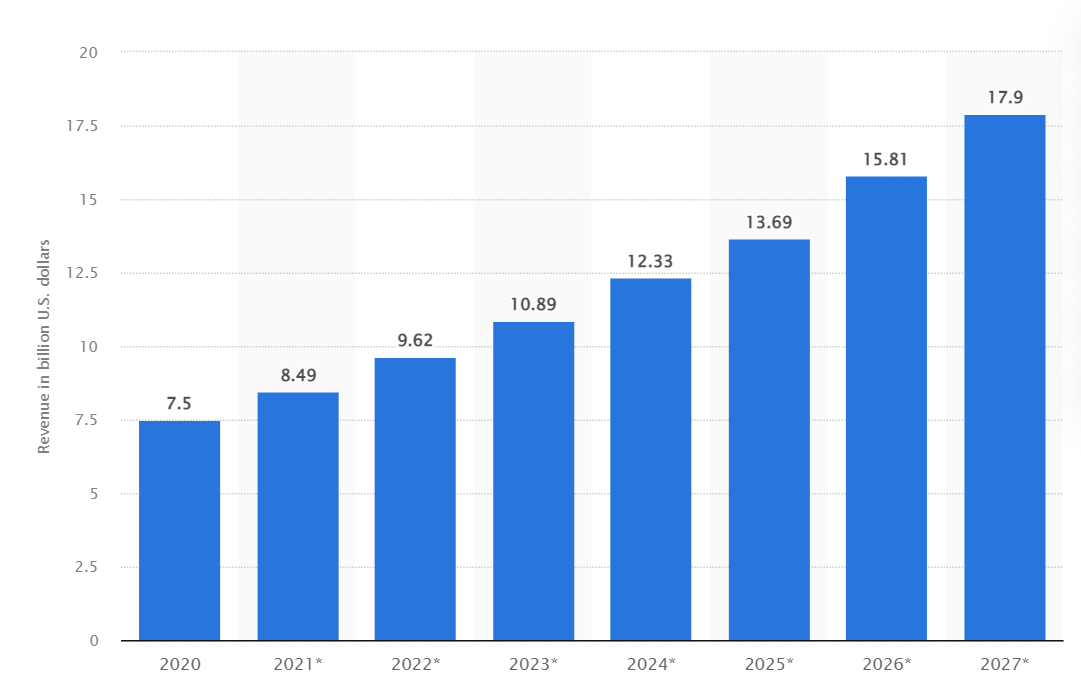
Email marketing comes in the form of newsletters, promotional offers, and other types of messages. They are delivered to your customers’ inbox and communicated directly with them.
A key benefit of this type of marketing is the ability to segment and customise your messages to different groups of customers, based on their preferences and behaviour. Catering messages to different groups of consumers increase the effectiveness of a business’ email campaigns.
If you want to learn how to write better email messages, read Best Email Writing Samples.
11. Search Engine Optimisation (SEO)
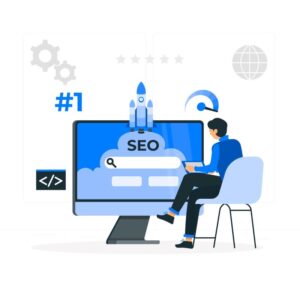 Search engine optimisation (SEO) is a process to improve a website’s visibility on the search engines results pages (SERP). This is done by optimising the website content and structure to improve the website’s ranking for relevant keywords.
Search engine optimisation (SEO) is a process to improve a website’s visibility on the search engines results pages (SERP). This is done by optimising the website content and structure to improve the website’s ranking for relevant keywords.
Effective SEO requires a combination of on-page, off-page, and technical SEO in order to improve search rankings.
On-page SEO ensures relevant keywords are placed in page titles and meta descriptions. Off-page SEO includes building backlinks to the website, and technical SEO ensures the website is loading fast.
SEO is important for businesses to drive organic traffic to the website, gain awareness of the brand, and ultimately drive sales. It’s vital to stay updated on the latest best practices and algorithm updates as they may affect website SEO.
Read: 9 Reasons Why Your Website Needs an SEO Agency
Conclusion
All the strategies can be implemented for both B2C and B2B businesses. While each of these strategies offers different and unique benefits, they require proper planning and execution. This may take up a significant amount of time and resources.
Also, do keep in mind that not all strategies may be suitable for the nature or scale of the business that you are marketing for. There may be budget and resource constraints to consider when deciding on the most appropriate method to use.
Don’t miss out on conducting research to find out the places or channels that your market spends time at, e.g. social media or organic search on Google. Deploy the appropriate digital marketing strategy or strategies that will likely produce the desired results.
Before you start implementing any strategy, create buyer personas and refine them whenever you need as these play a vital role in defining your marketing direction and help you set better marketing goals.
About Websparks
Websparks is an award-winning digital company based in Singapore with more than 14 years of operation. We offer digital marketing services in SEO, social media, content marketing and email marketing, web development, and web applications. Our team has worked on more than 500 projects for clients from different sectors. We are here to make your digital platform special.
Check out the full list of services.
Consult us to find out how we can help you achieve your digital dreams today.



